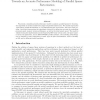Free Online Productivity Tools
i2Speak
i2Symbol
i2OCR
iTex2Img
iWeb2Print
iWeb2Shot
i2Type
iPdf2Split
iPdf2Merge
i2Bopomofo
i2Arabic
i2Style
i2Image
i2PDF
iLatex2Rtf
Sci2ools
AAECC
2007
Springer
2007
Springer
Towards an accurate performance modeling of parallel sparse factorization
We present a simulation-based performance model to analyze a parallel sparse LU factorization algorithm on modern cached-based, high-end parallel architectures. We consider supernodal right-looking parallel factorization on a bi-dimensional grid of processors, that uses static pivoting. Our model characterizes the algorithmic behavior by taking into account the underlying processor speed, memory system performance, as well as the interconnect speed. The model is validated using the implementation in the SuperLU DIST linear system solver, the sparse matrices from real application, and an IBM POWER3 parallel machine. Our modeling methodology can be adapted to study performance of other types of sparse factorizations, such as Cholesky or QR, and on different parallel machines.
AAECC 2007 | Algorithms | Parallel Machines | Parallel Sparse Lu | Simulation-based Performance Model |
| Added | 08 Dec 2010 |
| Updated | 08 Dec 2010 |
| Type | Journal |
| Year | 2007 |
| Where | AAECC |
| Authors | Laura Grigori, Xiaoye S. Li |
Comments (0)

